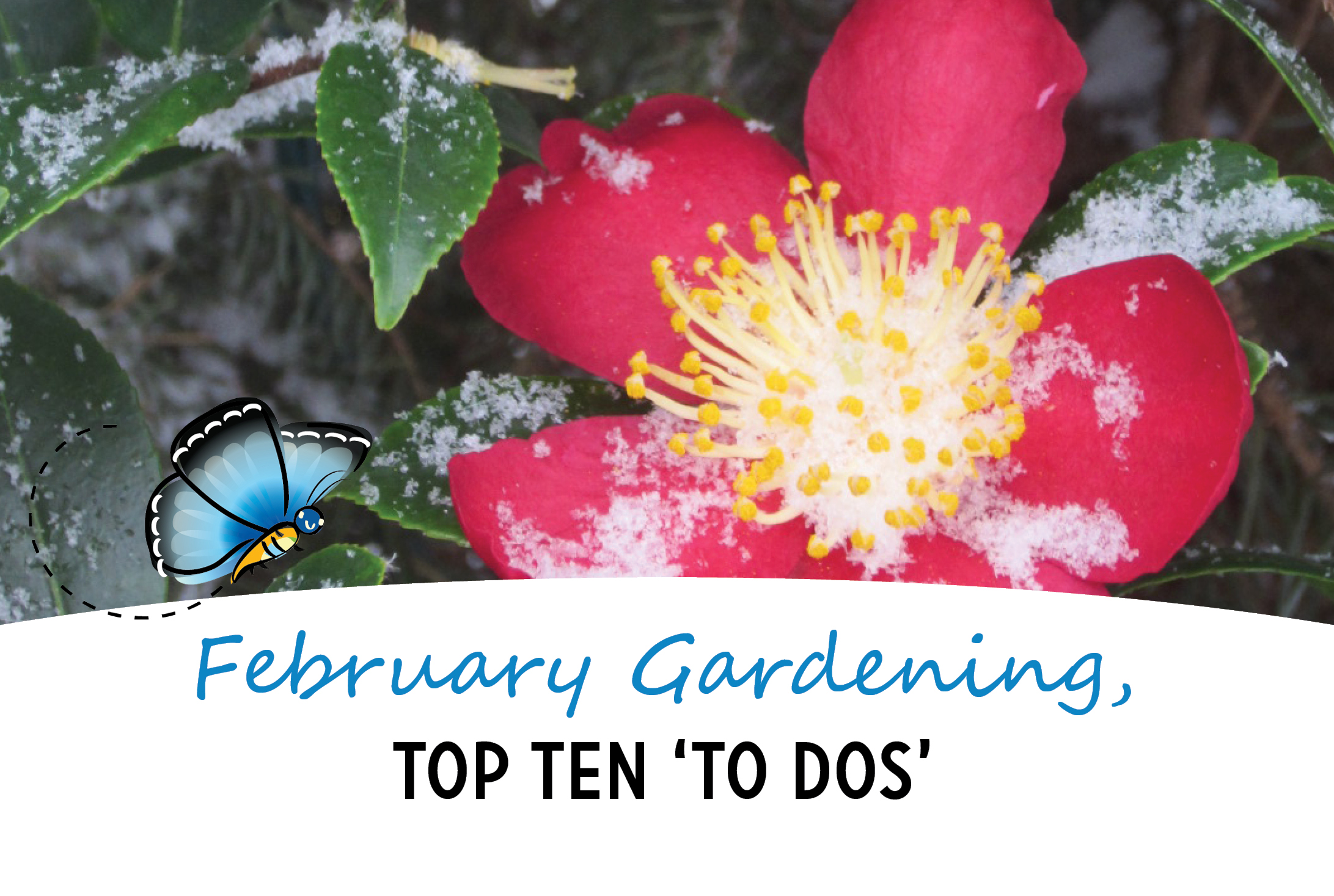By Minter Country Garden
Despite shorter winter days, there is a lot to be busy within the yard! Gardening is a fantastic activity for the mind, body and soul, and during cold grey days, it gives folks a sense of purpose and well-being. Many of the activities we do now lay the groundwork for stronger, healthier, more productive gardens later, so there are several long-term benefits too. Not sure what you should be doing right now? Read on for our top ten February ‘To Dos’:

Tip One
Clean up garden tools with a 10% bleach solution, sharpen blades, oil hinges and start up the mower. Taking good care of your garden tools will ensure they’re in good condition when you need them. Why bleach them? No, it’s not related to Covid-19. Cleaning hand tools that go from plant-to-plant will help prevent the spread of diseases.
Tip Two
Prune deciduous trees, shade trees, small fruits and fruit trees, ornamentals, evergreens (except pine and spruce which should be pruned closer to May) and non-flowering broadleaf evergreens. As a general rule of thumb, deciduous trees should be pruned during the dormant season when the leaves are off and before the sap starts to flow again. Different families of trees may have different pruning needs, so do a little homework before taking a blade to them. Flowering shrubs should typically be pruned immediately after flowering; pruning them now may result in cutting off this year’s blooms. Roses, however, should be pruned when yellow forsythia shrubs begin to bloom. For additional pruning tips, please visit the Resources page of our website!
Tip Three
Apply a preventative spray of dormant oil and lime sulphur on most deciduous trees and shrubs. Ideally, this should be done three times over the dormant season, but if you haven’t gotten to it yet, you can apply one ‘dose’ now, and follow up with the growing season ratios later in spring. Timing is critical on these springtime sprayings, so plan ahead carefully. Apply Copper spray, not dormant spray, to peach and nectarine trees to prevent peach leaf curl.
Tip Four
Set out Mason Bee cocoons and houses. Mason Bees are gentle, hard-working pollinators. Set out cocoons when temperatures are consistently about 10-13C or higher, and make sure they will have a food source near them when they emerge. Early blooming bulbs or winter heather are good options to have close by. Place Mason Bee houses in a sheltered spot under a house eave on the south or southeast side of your home (or similar location), and they may just make your garden their home-base!

Tip Five
Rake lawns and garden beds to gather any excess leaves that were missed in fall and add them to your compost bin. A few leaves here and there are helpful to wildlife, but excess leaves on our lawns can choke out the grass, herbaceous perennials and bulbs that will soon be growing below. Keep walnut leaves and cedar out of your garden compost.
Tip Six
Aerate lawns and apply 3/8” of coarse sand to improve drainage. Once you’ve aerated, rake the plugs away, then rake in the sand to fill the holes. This will improve drainage overall and thus make moss less inclined to take hold in your yard. If you did not apply lime to your lawn in the fall, you can do so now, ideally on a dry day right before rainfall.
Tip Seven
Plant out hardy hellebores, evergreen euphorbias, winter heathers and fragrant shrubs. Yes, you can plant perennials and shrubs now to enjoy for years to come. Early blooming plants provide much appreciated food for bees and other pollinators too. Remember the fragrance! ‘Viburnum ‘Pink Dawn’, Chinese witch hazel, sarcococca, wintersweet (chimonanthus) and winter flowering honeysuckle are just a few of our seasonal flowering favourites.
Tip Eight
Deadhead and clean up seasonal annuals. Fall-planted pansies, violas, bellis (English Daisies) and primulas appreciate a clean up to encourage re-blooming. When kept healthy, they will often bloom through to mid-Spring. Side dress with well-composted manure to give them a bit of a boost.
Tip Nine
Start seeds! Select plants, like giant Spanish onions, multipliers, broad beans, arugula and leeks, can all be started from seed in February, and locally sourced seed potatoes will arrive mid to late February. When starting seeds indoors, make sure you have an excellent source of light, good air circulation and a source of consistent warmth to get them off to a good start. Be mindful of timing too. Be sure to read the seed packages to determine the best timing for starting each type of seed so that they can be transplanted outdoors at the right time.
Tip Ten
Add to your indoor garden. When it’s just too wet and cold to work outdoors, it’s nice to be surrounded by lush, thriving tropicals inside. Add colourful foliage houseplants like calatheas, crotons, ‘Nanouk’ tradescantia, or long-blooming anthuriums, bromeliads and orchids, to brighten every day, or gift them to someone who might need a pick-me-up! New to indoor gardening? Some of the best indoor plants to start with include: snake plants, pothos, spider plants, ZZ plants, aloe vera and air plants. They’re all easy to grow and care for and are pretty forgiving if you are still in the learning process.
In addition to the above items, this is a great time to set out bird feeders, plan your spring edible garden (rhubarb, fresh herbs, early greens… delicious!) and purchase bulbs and seeds for summer gardens. Need a little guidance? Our garden store is open seven days a week and we’re happy to offer suggestions and inspiration to help you grow the garden of your dreams. We hope to see you soon!



